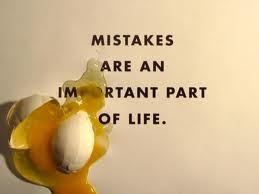This week’s blog post writer is Dawn Butler. Dawn is the Lead Course Specialist with Learners Edge. Prior to joining the Edge, Dawn was a high school English teacher for 11 years. In her free time, she can be found wrangling her 6 year old son, 3 year old daughter, 2 cats, and a dog. Her parents were teachers, her husbandis a SPED teacher, and her parents-in-law are teachers, which really helps Dawn to continue to foster her passion for education as she works to offer the best possible courses at the Edge!
If I were to make a list of all the mistakes I have made in my life that have paid dividends – I would have an extremely long list. Everything: a failed engagement, bad/lousy career choices (an ad exec? really?), bad lesson plans, hairstyles and prioritizing….all of those things have made me into the person I am today. All of those mistakes have (except for the hairstyles) made me wiser and more informed. In fact, I would guess that many adults I know (and many of you I don’t) would attest that mistakes, actually, make us smarter.
When I was a child, I remember distinctly how it felt to make a mistake. I don’t think it had anything to do with my upbringing, but I had a self-imposed rush of adrenaline that would make me very uncomfortable and very wary of ever making a mistake again, especially if it affected other people. Shoot, when I learned to knit (at 34), I must have cried half a dozen times, because I wasn’t getting the hang of it right away. It didn’t feel good, and it’s exhausting. Making mistakes is something that has certainly gotten easier with age.
But, as you probably know, there’s a whole bunch of students out there who are afraid to make mistakes. According to this article on Edutopia by Alina Tugend, there’s even a term for it: “victims of excellence.” They don’t want to screw up. The article offers great insight into this issue. It goes beyond making mistakes, though – this issue is also about not being able to achieve perfection.
Remember when a “C” meant “Average”?Now, it seems that it is the equivalent of a F; kids who earn Cs are just not able to cut it. A “C” is completely unacceptable.One of the only things worse might be an “A-“; such a thing must just grate on the nerves of students who have this mindset.
It’s unfortunate in so many ways, that there becomes less and less room for mistakes in the worlds of children. How did we get here, I wonder? We cannot allow this generation to function in this way; there needs to be a mind shift somehow that includes drive and creativity, but not a fear of mistakes.
Mistakes are more often punished than seen as an opportunity to learn. What then can we do to help our students learn from their mistakes and remove the stigma of making mistakes?
- Allow students to correct mistakes on a test or assignments. Of course, you can decide if you want to give them credit for doing so, but just being able to correct those mistakes takes some of the edge off.
- Be playful about mistakes. Maybe everyone cheers. Having fun with it associates mistake making in a positive way.
- Publicly own andcelebrate your own mistakes. Maybe the whole class does a goofy sound, or a standing ovation, every time you make a mistake. Always admit it! Cloaking mistakes in embarrassment or secrecy casts a negative tone.My husband evenallows students to pick a piece of candy or a treat every time he makes a mistake.
- Go the way of Sara Blakely’s father and ask your students, “How did you fail today?” This may even be something students can write about in their journals if they are processing their day.Then celebrate, and discuss any lessons learned.
To err is human and mistakes are a very important part of the learning process. Instead of fearing mistakes we need to teach children to learn from and improve from their mistakes. When mistakes become learning opportunities, students take more risks, think in new, creative ways, cheat less and solve problems that had previously eluded them.
How do you make it “safe” in your classroom for your students to make mistakes?
Learners Edge is passionately committed to providing you with continuing education coursework, materials, and tools that will help you succeed in your classroom and in your career.
Offering more than 100 print-based or online courses for teachers, you can earn the graduate credit you need for salary advancement and meet your professional development needs. Contact us today to get started!






